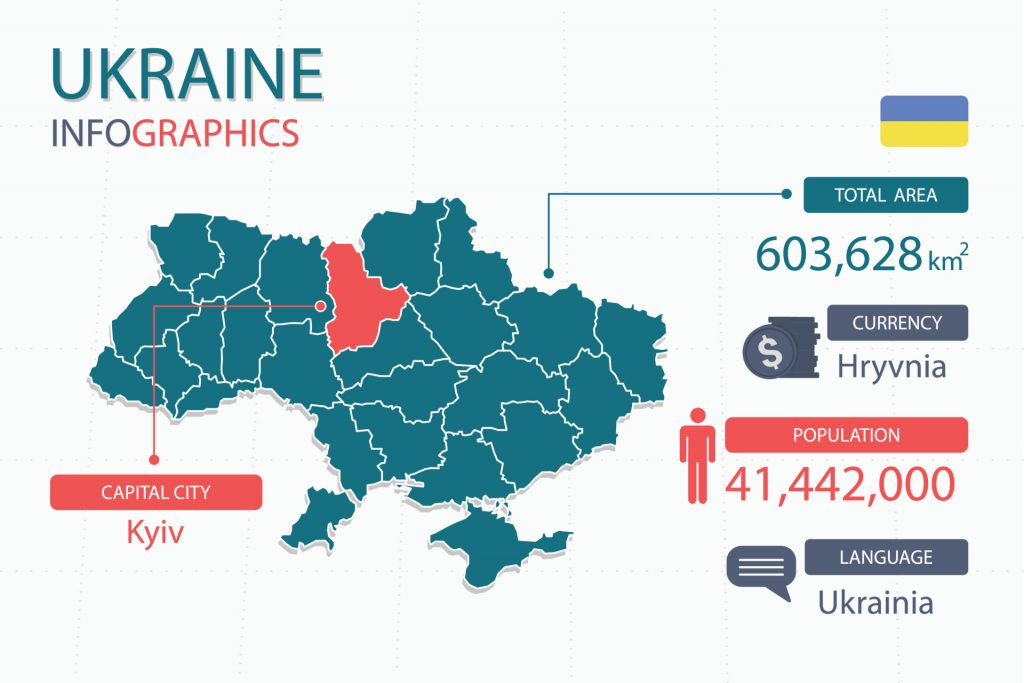The origins of the Ukrainian Language
The Ukrainian language is a language spoken by about 45 million people, mostly in Ukraine. Here, it is the official language and also the first of one of two main languages. It is also an official language in Transnistria, a country that is not legally recognized by any official body, and currently located in the Republic of Moldova. It is regulated by the National Academy of Sciences of Ukraine. It is, to a large extent, mutually intelligible with Belarusian and Russian as well.
Features that make it unique include its case system, with seven cases, and unlike Russian, it has retained the vocative case. It classifies nouns into three grammatical genders (masculine, feminine, and neuter). With both a case and gender system, the sentence order can be extremely flexible, even though its base pattern is subject-verb-object.
Ukrainian’s writing system is Cyrillic, albeit with Ukrainian characteristics. There are 33 letters and it tries to be as phonemic as possible; that is, one letter usually corresponds to one sound. However, as with all writing systems, there are some exceptions. It is written from left-to-right like other Cyrillic-based writing systems.
It is part of the East Slavic language family. Other languages that are included in this family are Russian, Belarusian, and Rusyn. The East Slavic language is also part of the broader family of Slavic Languages which includes Slovak and Polish, languages with which it shares some similarities as well, especially in terms of Polish terminology.

The history of Ukrainian starts during the Khazar period, when the territory that is present-day Ukraine was settled by Iranian, Turkic, and Uralic tribes. In addition, Slavic tribes from the north also migrated into the area. At this time, the language was known as Old East Slavic, a language that linguists consider to be a group of diverse dialects, with characteristics of a dialect dependent on the tribe that spoke it. In terms of literature, the language that is present in it is called Old Slavonic.
After the fall of Galicia-Volhynia, which was present in that region at that time, the Ukrainian people fell under the rule of Lithuania, and then Poland. Under Lithuanian rule, there was a high level of local autonomy, with Ukrainians being able to reserve their language. However, Polish rulers put into practice more aggressive policies of assimilation. At this time, Ukrainian nobles learned the Polish and adopted the Catholic religion. As such, a heavy Polish influence entered the language. During this time, there were also some borrowings form Tatar and Turkic languages.
In the 17th century, languages were heavily associated with religion in Ukrainian areas. Catholics tended to speak Polish, while Orthodox Christians tended to speak the Ruthenian language, considered the predecessor of modern Ukrainian. In the 18th century, more influences from both Polish and Russian sources occurred; the region that is present-day Ukraine was divided under Polish and Russian territories. The Ukrainian varieties under Polish territories had more of a Polish influence, as well as speaking more Polish in general, while the ones under Russia were naturally more inclined to Russian linguistic tendencies.
However, at the same time, there was a strong revival of national identity and self-identification, especially among the literary classes. They wanted to make Ukrainian not just a local second-class dialect, but a flourishing literary language. Under the Russian Empire at the time, however, Ukrainian was banned as a language of instruction in schools. Further politically motivated changes seemed to hinder the development of Ukrainian, such as the closing of the Kyiv-Mohyla Academy, an institution that promoted Ukrainian language and culture, termination of a number of other groups that spoke Ukrainian, closing of Ukrainian-language magazines and newspapers. However, in 1917, after the Russian Revolution, Ukrainian experienced a series of revivals and suppressions.
In the modern era, policies that promote Ukrainian thrive in the Ukraine and it is very symbolic of the Ukrainian identity. In practice, however, it is not as unified as it seems. While after a long period of suppression, the use of Ukrainian has increased, Russian language still dominates print media in most of Ukraine, as well as private radio, and TV broadcasting. Even within the country, some people still consider Ukrainian as a Russian dialect, thus there is still large contention. In fact, in regions of Ukrainian closer to Russia, people tend to identify more with the Russian language and culture, and efforts to promote policies favoring Ukrainian are met with stiff resistance. However, Ukrainian is considered to be the native language of about 66 percent of the entire population of Ukraine, which while still is a majority, can provide a perspective as to why Russian is still dominant. The number of speakers who claim Russian as a native language are about 35% while other ethnic minorities claim other languages. However, most of the population uses Russian as a lingua franca.
Despite these numbers, there is a large body of Ukrainian literature developing, and especially in modern times after the 2010s, a Ukrainian pop culture has rapidly developed, especially in terms of music, cinema, and other arts. In music, popular Ukrainian rock bands tour internationally. There are even Ukrainian language bands that originate from other countries such as the United Kingdom and the United States. The cinema and film scene has also been quite active. Thus Ukrainian seems to be a language that will continue to evolve and grow, being a representation of the Ukraine for some time to come.
VEQTA can provide you with a perfect Ukrainian translator for your Ukrainian translation, English to Ukrainian translation and Ukrainian to english translation for the your targeted locale. Our translations to Ukrainian are created with your target audience in mind to meet your expectations.
If you need to translate Ukrainian – Get in touch today!
A dedicated team of Ukrainian translators who combines Experience, Specialized Subject Matter Expertise with best Translation Practices to deliver quality second to none.
Ukrainian Document Translation
Ukrainian Legal Translation
Ukrainian I.T Translation
Ukrainian Health & Fitness Translation
Ukrainian Medical Translation
Ukrainian Marketing Translation
Ukrainian Financial & Accounting Translation
Ukrainian Tourism & Travel Translation


